IMAGES BY: Andrea Lombardo
WRITTEN BY: Ryan Nemeth
What do Thomas Edison, hormones, sleep apnea, astronomy and circadian rhythms have in common? If you guessed that all share some connection to global light pollution, then you are either way too smart for me or you have too much time on your hands. It may be a new concept for some, but you should know that light pollution is a real thing and does exist. Light pollution is defined as an unintended brightening of the night sky that is caused from excessive, misdirected or obtrusive light. This form of pollution distorts colors of the night sky and interferes with our ability to see the stars as a result of sky glow. Furthermore, light pollution disrupts the environment at large by intervening in the natural daylight and night cycles that help to drive many necessary biological functions in nature.
The story and evolution of light and the unintended consequences of light pollution begin with fire. Historical records reveal that our human preoccupation with carrying and containing sources of fire and light far predate the first civilized societies as both heat and light are vital to our human existence. In fact, Darwin himself considered language and the ability to create fire the two most defining evolutionary qualities of the Homo Sapien species. Thus, it is not too surprising to learn that the earliest known stone lamps have been dated to the Pleistocene epoch and are thought to be approximately 40,000 years old. The take away: where humans go, light follows.
So you ask, what is light? Visible light is the small range of electromagnetic radiation that is detected by our eyes. This form of light is comprised of photons that are emitted when energy sources release their energy in the form of electromagnetic radiation (EMR). Not surprisingly, some energy and light emitting sources are more efficient than others in producing light photons. Subsequently, humans have developed and adopted many combinations and forms of energy and light emitting technology. The abbreviated history of light and the trajectory of its development follows a path akin to this; Wood fire and torches 125,000 B.C., stone lamps 40,000 B.C., oil lamps 4500 B.C., candles 3000 B.C., first crude kerosene lamp 900 A.D., gas lamps 1792, incandescent lamps 1874, the first incandescent lighting system based on AC current 1886, mercury-vapor lamps 1901, neon lamps 1910, fluorescent lamps 1926, and LED lamps 1962.
What might be surprising to many, given the brief timeline of electric lighting, is the fact that electric based derivatives of light did not show up until the late 1800s. Furthermore, it is somewhat startling to think that humans have managed to whitewash much of the globe with artificial light in just a mere 150 years. You should know that both electric lights and gas lamps are products of the industrial revolution and these inventions marked a huge paradigm shift in the way that light was produced, transmitted and consumed. For the first time in history, we (humans) no longer had to tend a fire to light our world. We had systematically engineered a way to turn a switch and walk away. The intended consequences were that society could now remain productive 24 hours a day on a diurnal cycle void of sun. Thus, the industrial revolution and the invention of the gas lamp marks the spot in our history where humanity made a considerable lifestyle break from productive work hours that were dependent on the light of the sun. Coincidentally, the development of artificial light also coincides directly with our larger global transition from agricultural to industrialized economies. Thus, the role that artificial light played in our larger socioeconomic transition and continues to play in defining and shaping our urban existence should not be discounted.
From the dawn of civilization, fire in the home and light were often one and the same. Wolfgang Schivelbusch stated in his book Disenchanted Night, “When the house lost its hearth fire, it lost what since time immemorial had been the focus of its life.'' This paradigm shift marks a rapid progression in the way that society consumed light in their homes as well as their businesses. As one can imagine, families no longer had a need for gathering around a single source of heat and light. The once vital community chores of chopping wood and tending the flame suddenly disappeared. Gas lamps, railroad access and utilities (water and gas) were suddenly available in many homes within a very short span of time. One can only speculate just how much these inventions changed interpersonal communication, psychology and the overall orientations of the family unit and the broader community as we were suddenly freed from necessary but burdensome chores. If one is inclined to ponder the degradation of family and the loss of community in the modern world, I would suggest that the investigative journey start here. The unintended consequence of artificial light was a large societal shift resulting from newly lite environments that encouraged exploration, access, independence and new forms of community outside of the home. These newfound freedoms propelled individuals to seek out taboo and forbidden dimensions of the night as well as productive nocturnal environments, this lead to a dramatic increase in the hours of lighting (energy) that society consumed.
Paradoxically, something very interesting and troublesome transpired as industrial societies began to free themselves from a dependency on land and agricultural based orientations. This massive industrial transition created an unquenched need and thirst for more energy. Industrial economies suddenly needed fuel and stores of energy for their factory based infrastructure, machine based productivity, transportation of goods and materials and also for the coinciding urban growth. To this day, progress in the global industrialized economies of the world remains highly dependent on the security of cheap and renewable demand driven energy stores. Furthermore, these same energy requirements hold true for our newer service based economic models. Looking back, what prompted dramatic change in the late 1800s was our ability to create and extract cheap sources of energy (coal, petroleum, natural gas, and hydro-electric power) and to transmit this energy over long distances to those in need. This industrialized shift in the transmission and consumption of energy meant that family units, communities and individuals no longer had to secure their own power. One of the biggest ramifications for life under this new model was that society no longer bore the burden to harvest, maintain and manage personal energy stores. Due to the gains associated with the specialization of labor, it became more efficient for centralized organizations to secure and manage energy resources for us. Thus, energy consumption transitioned to a place that was no longer dependent on personal productivity, but a function of market based supply and demand and relevant energy pricing structures.
The advance of the industrialized market-based energy economy was an amazing breakthrough for society both in the form of productivity and leisure. However, because energy was and still is cheap relative to wages in the developed world, there remains very little downward market price pressure to discourage consumers into actions of energy conservation. A consequence being that it is cheap to leave the lights on. As a result, many of us in the developed world still continue to do so. Fast-forward one hundred and fifty years and it turns out that wealthy countries with vast energy stores and resources are those that contribute most to global light pollution. Looking at lighting maps of earth from space reveals that the United States, Europe and Japan are some of the worst light pollution offenders on the planet. The patterns and disbursement of global lighting make it fairly easy to conclude that light pollution is not simply a result of population density, but also a by-product of wealth. Thus, our massive and impersonal energy systems driven by consumer based cultures and failed resource management policies have yielded a modern world begging for improvements in lighting efficiency and the way we light our world. (see maps below)
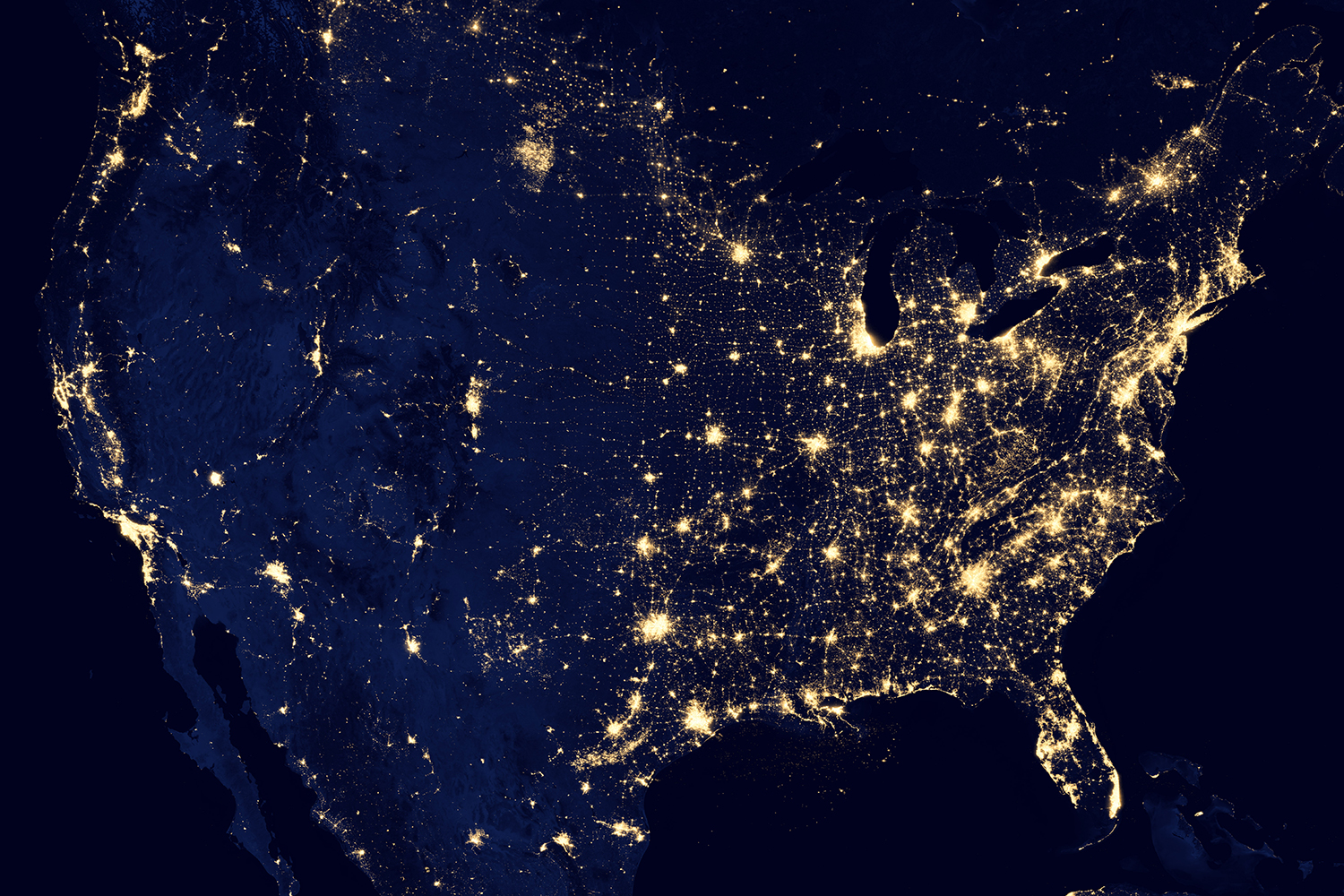

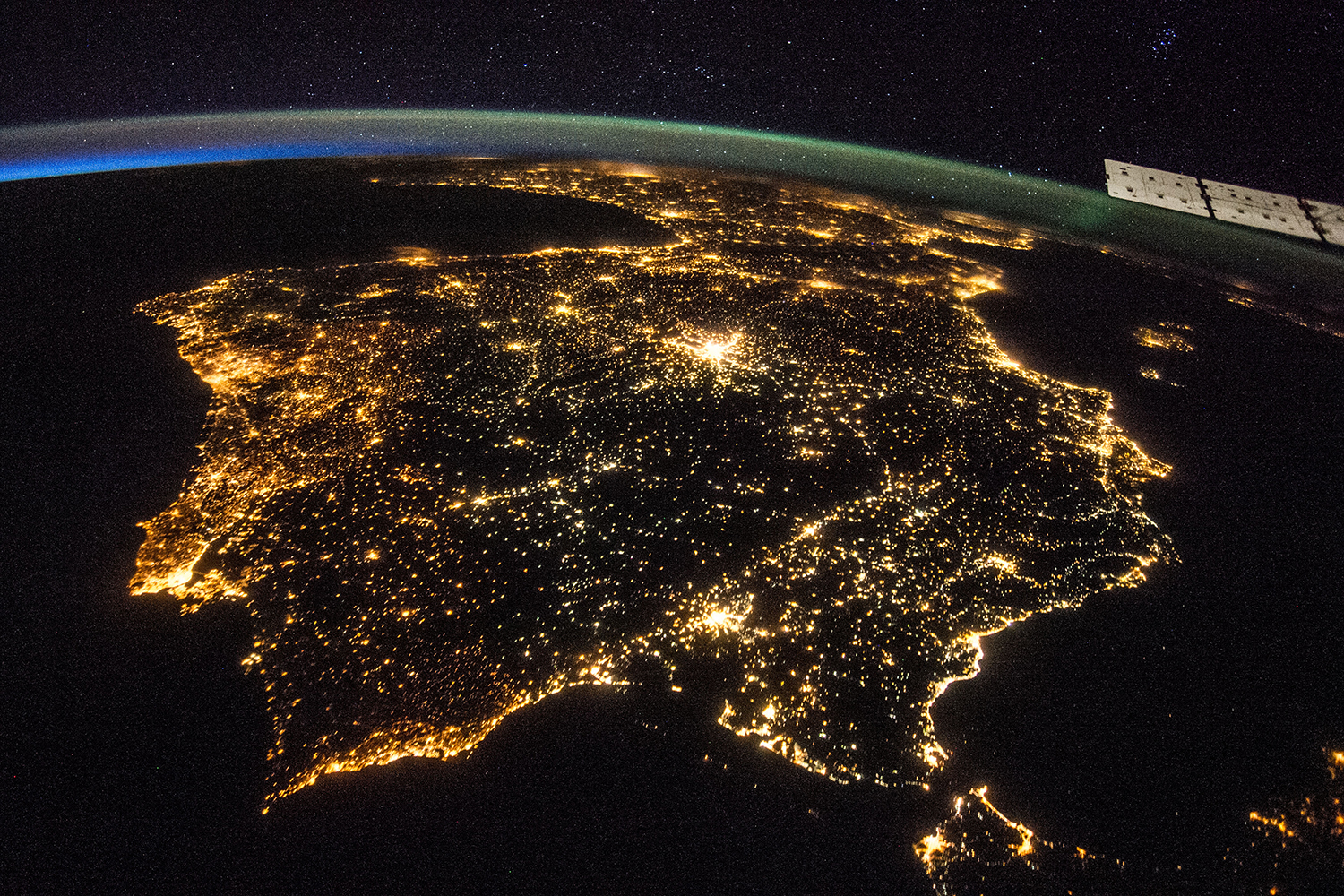
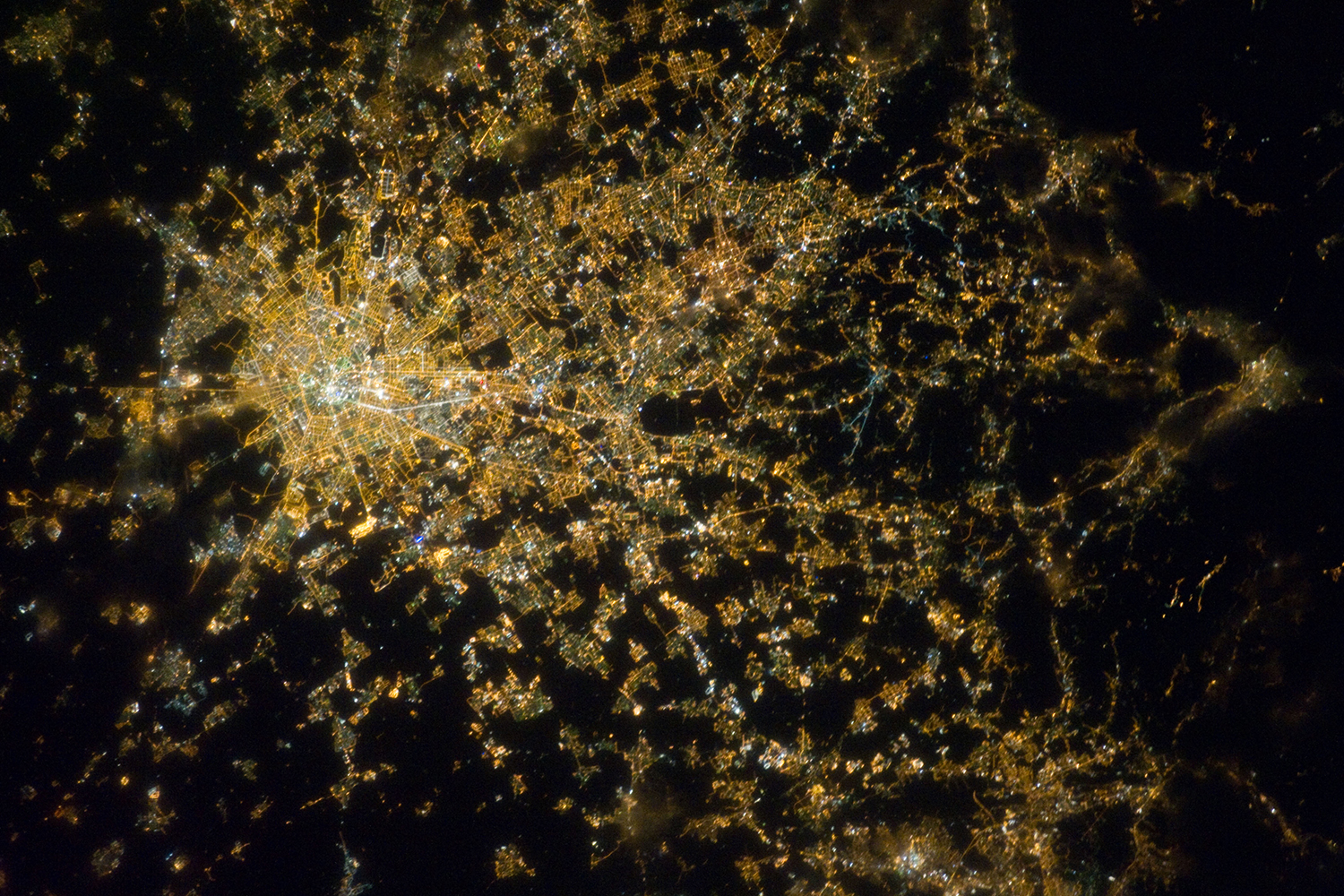
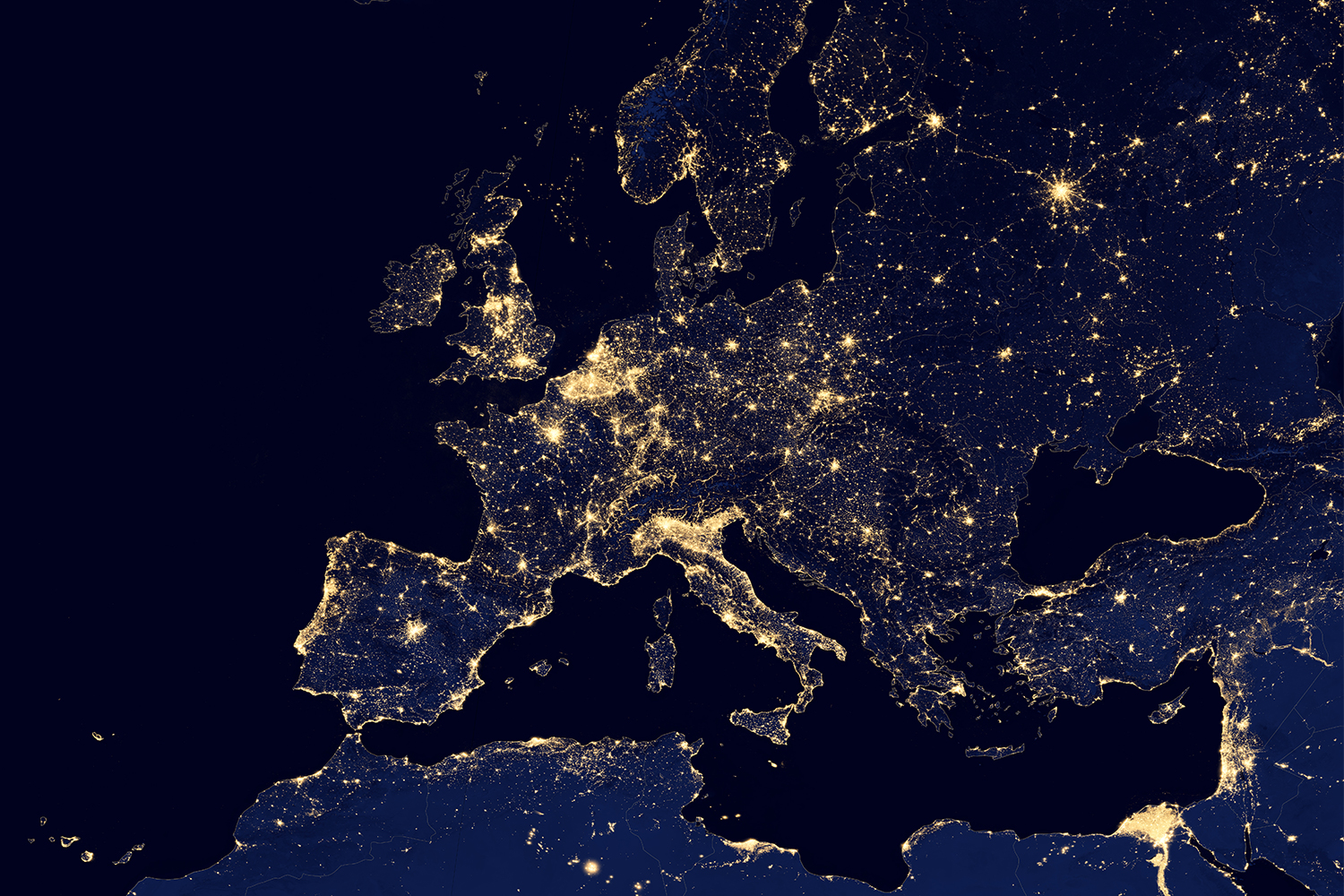
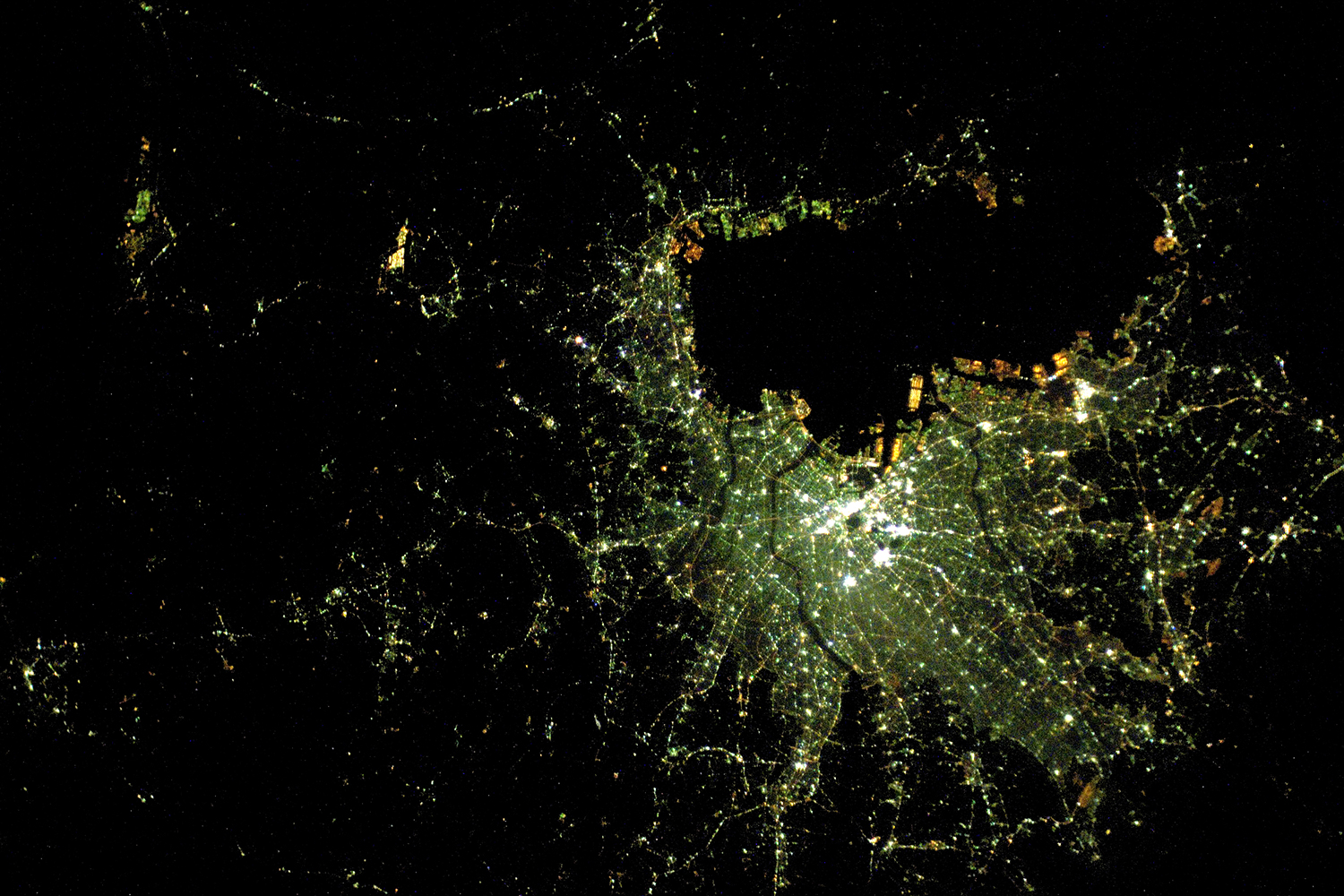
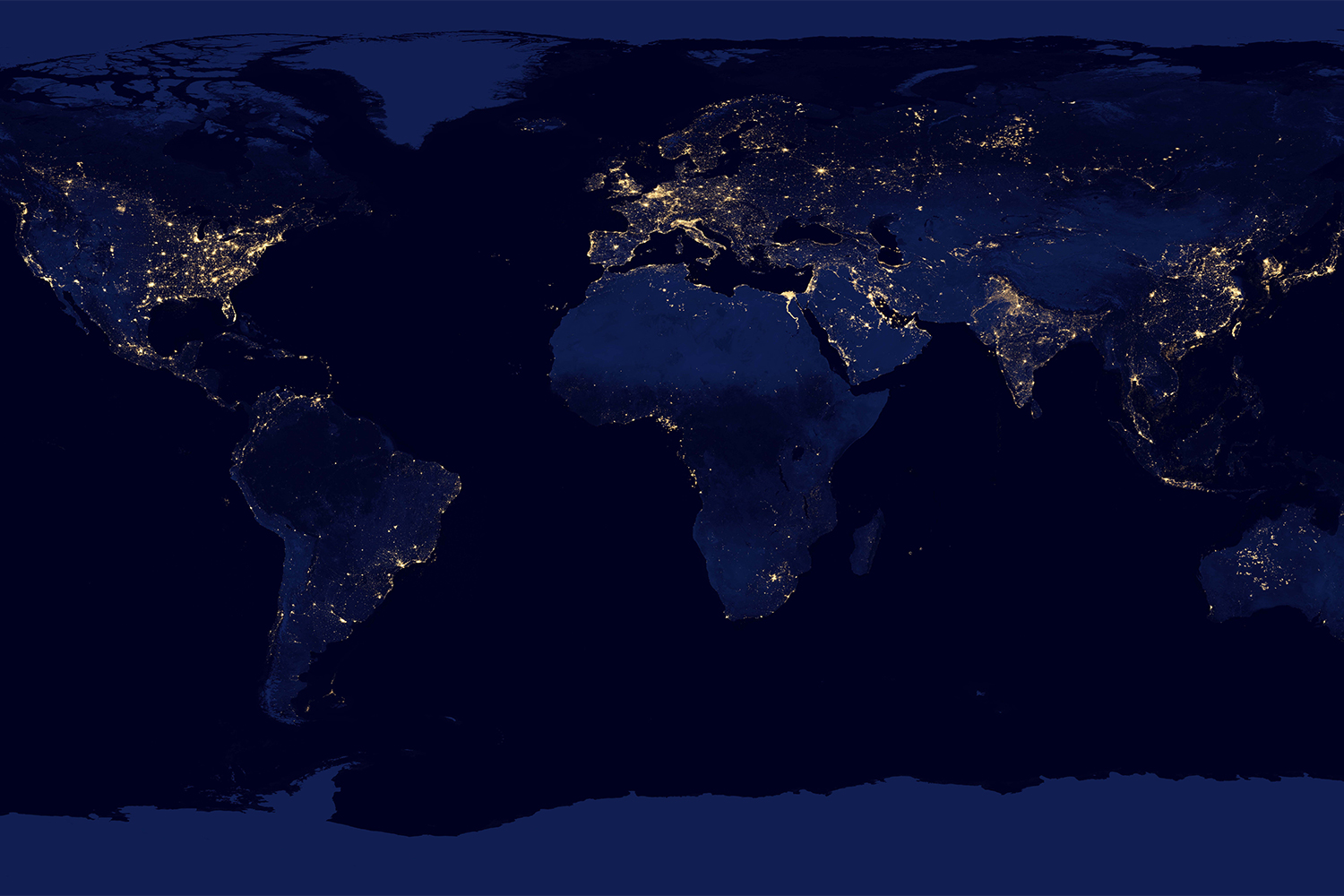
Interesting patterns show up in the lighting map of the United States; light pollution is substantially less prevalent West of the Mississippi River. Also, patterns of North-South and East-West are revealed in the Interstate lighting system; uncovering rectangular patterns (grid) found in the design of our transportation corridors. In Las Vegas, NV, areas of town most likely associated with casino development and newer LED lights emit a much bluer and whiter light into the atmosphere. Images from Milan reveal a city that casts orange hues of light associated with the widespread use of sodium vapor lamps. You will also notice that Tokyo city lights cast a very green hue of light; this is created from the widespread use of Mercury Vapor lamps.
According to a report on global light pollution published in the Monthly Notices of the Royal Astronomical Society, two-thirds of the U.S. population and more than one-half of the European population have already lost the ability to see the Milky Way with the naked eye. Moreover, 63% of the world population and 99% of the population of the European Union and the United States (excluding Alaska and Hawaii) live in areas where the night sky is brighter than the threshold for light-polluted status set by the International Astronomical Union. In translation, the lumen output from artificial light measures greater than 10% of natural sky brightness above 45° of elevation, confirmation that our world is filled with light pollution.
So the question is why care, what are the broader ramifications of light pollution on the environment and society, if any? Astronomical communities and those who care about seeing the stars at night have long been at the forefront of the dark sky movement and other light pollution reduction initiatives. However, for many, the interfering glow of city light that prevents us from seeing the stars at night remains inconsequential, trivial and seemingly non-necessary for a vibrant and knowledgeable earthly existence. Thus, it is easy to understand why light pollution initiatives might be easily dismissed as unimportant or inconsequential. However, if one is willing to dig, the problem of light pollution remains larger and much more complex than one might first suspect.
For many eons, life has relied on the predictable rhythms of day and night created by earthly interactions with the sun. This 24-hour day and night cycle, known as the circadian cycle, affects physiologic processes in organisms as it is encoded in the DNA of humans, plants and animals. Studies of humans reveal that circadian cycles interact directly with approximately 10-15% of our genes. This interaction shows up in brain wave patterns, hormone production, cell regulation, and other vital human biologic activities. A few of the documented and associated human disorders linked with disruptions in circadian rhythm cycles include depression, insomnia, cardiovascular disease, and cancer. Beyond human aspects of light pollution, plants and animals also depend on the earth’s daily cycle of light and dark to govern life-sustaining behaviors such as reproduction, nourishment, sleep and protection from predators. Thus, artificial light in the night sky can have a very disruptive effect on the natural rhythms that help to create cyclical order and biological balance in our world.
Case in point, migrating birds seems to be heavily affected by glare and sky glow associated with artificial lighting in the night’s sky. In North America alone, about 200 species of birds fly migration patterns during the night. When inclement weather and low cloud cover is present, birds demonstrate that they are routinely confused in their passage and navigation near brightly lit buildings, communication towers and other pervasive landscape structures. Each year in New York City alone, about 10,000 migratory birds are injured or killed by crashing into skyscrapers and high-rise buildings. Current estimates for the number of birds that die from collisions across North America range widely from 98 million to close to a billion. However, the U.S. Fish and Wildlife Service estimates that 5 to 50 million birds die each year from collisions with communication towers alone. Expanding and extrapolating from these numbers to our larger global environment yields staggering numbers of loss for migratory birds. Thus, the coinciding death and birth rates as well as natural predator and prey relationships that interact with migratory bird populations have dramatically shifted as a result of artificial light. What humans must comprehend is that light pollution can and does have dramatic implications for the vitality of many species of plants and animals. It should be noted that there are numerous other nocturnal animals such as bats, frogs, turtles, fish, and rodents that also have been directly and adversely affected by light pollution. This negative interaction with nightlight extends even further into insect species as well as plants. In summary, the effects of light pollution are comprehensive and non-discriminating in the biological world.
Take for example, the changes in human patterns of sleep that have coincided with the industrial revolution and coinciding lighting boom. The sleep pattern that was the norm before the invention of electric lights is no longer the norm in countries where artificial light extends the day. In the 2005 book At Day’s Close: Night in Times Past, historian Roger Ekirch of Virginia Polytechnic Institute described how before the Industrial Age people slept in two 4-hour shifts (“first sleep” and “second sleep”) separated by a late-night period of quiet wakefulness. Thus, sleep cycles as governed by melatonin cycles that correlate to periods of light and dark were very different in the Pre-Industrial Age. Could the rise of endocrine related disorders, sleep disorders and other human diseases simply be related to the irregular circadian cycles and corollary gene, endocrine and immune responses in the body?
The evidence that indoor artificial light at night influences human health is fairly strong, but how does this relate to light pollution? The work in this area has just begun, two recent studies in Israel have yielded some intriguing findings. Both studies used satellite photos to gauge the level of nighttime artificial light in 147 communities in Israel. The data was collected and researchers then overlaid the photos with a map detailing the distribution of breast cancer cases in these areas. The results yielded a statistically significant correlation between outdoor nighttime artificial light and breast cancer, even when controlling for population density, affluence, and air pollution. Women living in neighborhoods where it was bright enough to read a book outside at midnight had a 73% higher risk of developing breast cancer than those residing in areas with the least amount of artificial lighting outdoors. Clearly this research is eye opening, yet the data merely demonstrates statistical correlation and not causation. In other words, don’t go freaking out just yet. Rest assured that researchers are fast tracking to connect the dots and larger communities of health organizations are starting to ask questions with the intention of seeking answers.
It would be very hard to refute the fact that artificial light has benefited society by extending the length of the productive day while offering more time for recreational activities that require light. However, when artificial outdoor lighting becomes inefficient, annoying and or unnecessary, it is nothing more than a pervasive form of pollution. Many environmentalists, naturalists, and medical researchers consider light pollution to be one of the fastest growing and most intrusive forms of environmental pollution. Furthermore, it should be evident that chronic exposure to this form of pollution can lead to negative and potentially deadly effects for many creatures including amphibians, birds, mammals, insects, plants and humans. In 2008, the U.S. National Institute of Health (NIH) initiated its first multi-disciplinary research project on light pollution, this was a preliminary step to understand the comprehensive effects of light pollution and to try and corral a problem that is traveling at the speed of light. For some, the NIH’s involvement serves as evidence and acknowledgment of a much larger systemic problem. This being said, light pollution is still way down the list of important environmental issues needing further research and study. The use of excessive or unnecessary lighting also constitutes a waste of energy that is contributing directly to the release of carbon dioxide emissions and the warming of our global atmosphere. If you are at all inclined to believe that there are minimal consequences associated with leaving your lights on, think again!
References:
Adler, Jerry (2013). Smithsonian Magazine. Reference 1
G. A. Davis & J. D. Keller (2014). Reference 2
Maddox, B. (1989). Reference 3
Henley, J. (2009). Reference 4
Chepesiuk, R. (2009). Reference 5






























